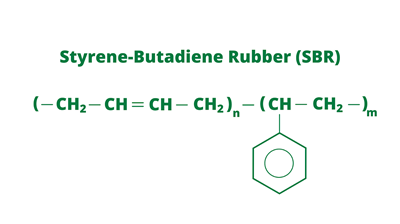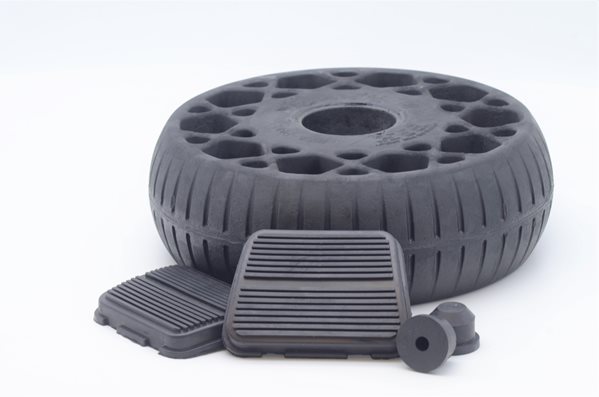Working Temperature Range:
High: 212°F / 100°C
Low: -50°F / -46°C
 What is SBR Rubber?
What is SBR Rubber?
SBR (Styrene butadiene) rubber is one of the first synthetic rubber materials ever invented. It has many of the same properties as natural rubber, but is petroleum-based rather than latex-based.
During World War II, natural rubber was needed for production of wartime materials like tires, tank treads, wire insulation and hoses and gaskets. As most natural rubber trees were found on islands controlled by Japan and the Axis powers, the government sponsored a research and development push to find a viable alternative to natural rubber for both wartime and consumer products.
This R&D push eventually established Neoprene and SBR rubbers as usable materials for rubber product production. Today SBR rubber is most often used in combination with natural rubber rather than as a substitute.
If SBR rubber is the ideal material for your application, give Custom Rubber a call. Even if you aren’t certain, our team of experts can help guide you. Contact Custom Rubber Corp. for answers to your natural rubber questions.
Discover More Engaging Content and Exclusive Insights by Clicking Here to Explore our YouTube Channel
Advantages of SBR Rubber
SBR rubber has excellent abrasion characteristics and reasonably good tear and elongation properties. A full list of advantages of SBR rubber includes:
- Excellent abrasion resistance
- Good tear resistance
- High electrical resistance
- Good crack resistance
- Low compression set
- Better heat resistance than natural rubber
- Resistant to non-petroleum-based fluids like alcohols, water, grease, etc.
- Odor resistant
Disadvantages of SBR Rubber
SBR rubber has disadvantages similar to natural rubber. They both demonstrate poor oil and ozone resistance. Other disadvantages of SBR rubber include:
- Poor resistance to petroleum oils and fuel
- Poor resistance to ozone and weather
- Low tensile strength
Commonly Asked Questions About SBR Rubber
The following questions regarding SBR rubber applications, properties and uses are frequently asked by our customers. Custom Rubber Corp. is here to provide answers and assist in your decision making process.
Q: What is the difference between SBR rubber and natural rubber?
While SBR rubber was designed as a synthetic alternative to natural rubber, and both materials share many of the same properties, SBR has some slight advantages. Mainly, SBR rubber has better ozone resistance and temperature capabilities.
Q: Why use SBR rubber instead of a natural rubber?
Most of the time SBR rubber and natural rubber are combined because they tend to work better together than apart. But in most cases you could choose either one in your application and the finished part would turn out basically the same.
There are specific cases in which one may be better than another, but they are rare. The Custom Rubber Corp. team can help you determine if your product lands in one of those rare cases.
Q: Where does SBR rubber come from?
SBR rubber is man-made, derived from a byproduct of oil refining. It involves polymerizing Styrene and Butadiene in a controlled setting, then adding curatives and fillers like sulfur and carbon black. The resulting material is then cured or vulcanized to make a rubber part.
Q: What are the types of SBR rubber?
There are two types of SBR rubber. Their difference is in the manufacturing process used to create them.
- Emulsion SBR (ESBR) is produced at a certain temperature, either a hot (122 to 140°F) emulsion or cold (41°F) emulsion. The difference in temperature leads to different properties within the final ESBR rubber products.
- Solution SBR (SSBR) is made in a hydrocarbon solution using an initiator like butyllithium. The resulting polymer has less chain branching and narrow molecular weight distribution. SSBR rubbers tend to have higher tensile strength and better tear resistance than ESBR.
Q: What is SBR rubber used for?
An overwhelming majority of the time, SBR rubber is mixed with natural rubber and used to create tires, shoe soles, lacrosse balls and other products that need tough tear and abrasion resistance. At Custom Rubber Corp., we often use SBR rubber in the production of bumpers, rollers and brake and pedal pads.Products commonly made of SBR rubber include:
- Pneumatic Tires
- Solid Wheels
- Brake Pedal Pads
- Roll Covers
- Electrical (Wire/Cable) Insulation
- Rubber Soles/Heels on Shoes
- Chewing Gum
Q: Is SBR rubber toxic?
This question is common in relation to synthetic rubbers. However, just because a material is synthetic does not mean it’s toxic. In fact, it is possible to formulate SBR rubber with all FDA-approved ingredients.
Q: Does SBR rubber harden?
SBR rubber will likely harden overtime, but the rate at which it hardens and how long it lasts depends on original formulation and the end product’s storage and application.
Q: Does SBR rubber burn?
SBR rubber can be formulated to be burn resistant by adding flame retardants, but typically it will burn. It has a fairly high ignition temperature, meaning temperature must be extremely hot to get it to burn. Once it does start, the resulting fire is extremely hot and hard to put out. Because these fires are so hard to put out, it’s often catastrophic when SBR rubber does catch fire, especially on a large scale. Tire fires have been known to devastate rubber and vehicle manufacturing plants.

Q: Does SBR rubber stretch?
SBR rubber can be formulated to stretch. Generally speaking, the lower rubber’s hardness on the durometer scale, the more it will stretch. SBR rubber formulated with low durometer will usually be stretchier than higher durometer formulations.
Q: What does SBR rubber cost?
The biggest consumer of natural rubber and SBR rubber is the car and truck tire industry, which makes tires out of a combination of both types. The ratio of natural to SBR can be shifted around in either direction with similar end results.
Because of this close relationship and flexibility in formulation, most manufacturers can change their process to add more of one type of rubber based on current market prices. When natural rubber prices go up due to a shortage, more SBR is used in formulation, which also changes the price of SBR. At the end of the day, pricing is too volatile and dependent on natural rubber to give a concrete answer to this question.
Q: What is the difference between Neoprene and SBR rubber?
Neoprene is a trade name, with the general name Chloroprene, abbreviated to CR. Though both are synthetic rubber types, the main differences between Chloroprene and SBR rubber are:
- SBR rubber has better heat resistance
- SBR rubber has better tear resistance
- Chloroprene is usually cheaper
- Chloroprene has fair oil resistance while SBR rubber has none
- Chloroprene has better ozone resistance
Q: What dissolves SBR rubber?
Because SBR rubber has poor oil resistance, any solvent-based fluid tends to dissolve SBR rubber. Liquids like turpentine, MEK or any oil-based liquid would most likely work.
Q: What are the common SBR rubber fillers?
Common SBR rubber fillers include:
- Carbon black
- Clay
- Calcium carbonate
- Silica
- Filaments or fiber reinforcing
Note that the cure agent, typically sulfur, is a key ingredient to any SBR rubber formulation, but it is not considered to be a filler. Sulfur is instead considered a catalyst.
Q: How can I purchase SBR rubber parts and products?
The Custom Rubber Corp. team has extensive experience in helping customers formulate SBR based rubber for their application and then designing parts that are manufacturable while meeting customer needs.
Is SBR rubber right for your application?
Contact the Custom Rubber Corp. team today.
Other Rubber Materials We Specialize In: